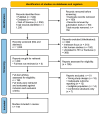Narrative Review on the Management of Neck of Femur Fractures in People Living with HIV: Challenges, Complications, and Long-Term Outcomes
- PMID: 40732042
- PMCID: PMC12299468
- DOI: 10.3390/microorganisms13071530
Narrative Review on the Management of Neck of Femur Fractures in People Living with HIV: Challenges, Complications, and Long-Term Outcomes
Abstract
Neck of femur (NOF) fractures are a critical orthopaedic emergency with a high morbidity and mortality prevalence, particularly in people living with Human Immunodeficiency Virus (PLWHIV). A combination of HIV infection, combined antiretroviral therapy (cART), and compromised bone health further increases the risk of fragility fractures. Additionally, HIV-related immune dysfunction, cART-induced osteoporosis, and perioperative infection risks further pose challenges in ongoing surgical management. Despite the rising global prevalence of PLWHIV, no specific guidelines exist for the perioperative and post-operative care of PLWHIV undergoing NOF fracture surgery. This narrative review synthesises the current literature on the surgical management of NOF fractures in PLWHIV, focusing on pre-operative considerations, intraoperative strategies, post-operative complications, and long-term outcomes. It also explores infection control, fracture healing dynamics, and ART's impact on surgical outcomes while identifying key research gaps. A systematic database search (PubMed, Embase, Cochrane Library) identified relevant studies published up to February 2025. Inclusion criteria encompassed studies on incidence, risk factors, ART impact, and NOF fracture outcomes in PLWHIV. Data were analysed to summarise findings and highlight knowledge gaps. Pre-operative care: Optimisation involves assessing immune status (namely, CD4 counts and HIV-1 viral loads), bone health, and cART to minimise surgical risk. Immunodeficiency increases surgical site and periprosthetic infection risks, necessitating potential enhanced antibiotic prophylaxis and close monitoring of potential start/switch/stopping of such therapies. Surgical management of neck of femur (NOF) fractures in PLWHIV should be individualised based on fracture type (intracapsular or extracapsular), age, immune status, bone quality, and functional status. Extracapsular fractures are generally managed with internal fixation using dynamic hip screws or intramedullary nails. For intracapsular fractures, internal fixation may be appropriate for younger patients with good bone quality, though there is an increased risk of non-union in this group. Hemiarthroplasty is typically favoured in older or frailer individuals, offering reduced surgical stress and lower operative time. Total hip arthroplasty (THA) is considered for active patients or those with pre-existing hip joint disease but carries a higher infection risk in immunocompromised individuals. Multidisciplinary evaluation is critical in guiding the most suitable surgical approach for PLWHIV. Importantly, post-operative care carries the risk of higher infection rates, requiring prolonged antibiotic use and wound surveillance. Antiretroviral therapy (ART) contributes to bone demineralisation and chronic inflammation, increasing delayed union healing and non-union risk. HIV-related frailty, neurocognitive impairment, and socioeconomic barriers hinder rehabilitation, affecting recovery. The management of NOF fractures in PLWHIV requires a multidisciplinary, patient-centred approach ideally comprising a team of Orthopaedic surgeon, HIV Physician, Orthogeriatric care, Physiotherapy, Occupational Health, Dietitian, Pharmacist, Psychologist, and related Social Care. Optimising cART, tailoring surgical strategies, and enforcing strict infection control can improve outcomes. Further high-quality studies and randomised controlled trials (RCTs) are essential to develop evidence-based guidelines.
Keywords: HIV; antiretroviral therapy; bone mineral density; femur neck fractures; systematic review.
Conflict of interest statement
The authors declare no conflict of interest.
Figures





Similar articles
-
Surgical approaches for inserting hemiarthroplasty of the hip in people with hip fractures.Cochrane Database Syst Rev. 2025 Jun 13;6(6):CD016031. doi: 10.1002/14651858.CD016031. Cochrane Database Syst Rev. 2025. PMID: 40511667 Review.
-
Surgical interventions for treating extracapsular hip fractures in older adults: a network meta-analysis.Cochrane Database Syst Rev. 2022 Feb 10;2(2):CD013405. doi: 10.1002/14651858.CD013405.pub2. Cochrane Database Syst Rev. 2022. PMID: 35142366 Free PMC article.
-
Cephalomedullary nails versus extramedullary implants for extracapsular hip fractures in older adults.Cochrane Database Syst Rev. 2022 Jan 26;1(1):CD000093. doi: 10.1002/14651858.CD000093.pub6. Cochrane Database Syst Rev. 2022. PMID: 35080771 Free PMC article.
-
Surgical interventions for treating intracapsular hip fractures in older adults: a network meta-analysis.Cochrane Database Syst Rev. 2022 Feb 14;2(2):CD013404. doi: 10.1002/14651858.CD013404.pub2. Cochrane Database Syst Rev. 2022. PMID: 35156192 Free PMC article.
-
Rehabilitation for ankle fractures in adults.Cochrane Database Syst Rev. 2024 Sep 23;9(9):CD005595. doi: 10.1002/14651858.CD005595.pub4. Cochrane Database Syst Rev. 2024. PMID: 39312389
References
-
- Palella F.J., Jr., Delaney K.M., Moorman A.C., Loveless M.O., Fuhrer J., Satten G.A., Aschman D.J., Holmberg S.D., the HIV Outpatient Study Investigators Declining morbidity and mortality among patients with advanced human immunodeficiency virus infection. N. Engl. J. Med. 1998;338:853–860. doi: 10.1056/NEJM199803263381301. - DOI - PubMed
-
- Marcus J.L., Leyden W.A., Alexeeff S.E., Anderson A.N., Hechter R.C., Hu H., Lam J.O., Towner W.J., Yuan Q., Horberg M.A., et al. Comparison of Overall and Comorbidity-Free Life Expectancy Between Insured Adults With and Without HIV Infection, 2000–2016. JAMA Netw. Open. 2020;3:e207954. doi: 10.1001/jamanetworkopen.2020.7954. - DOI - PMC - PubMed
-
- Gupta S.K., Yeh E., Kitch D.W., Brown T.T., Venuto C.S., Morse G.D., Ha B., Melbourne K., McComsey G.A. Bone mineral density reductions after tenofovir disoproxil fumarate initiation and changes in phosphaturia: A secondary analysis of ACTG A5224s. J. Antimicrob. Chemother. 2017;72:2042–2048. doi: 10.1093/jac/dkx076. - DOI - PMC - PubMed
Publication types
LinkOut - more resources
Full Text Sources
Research Materials

